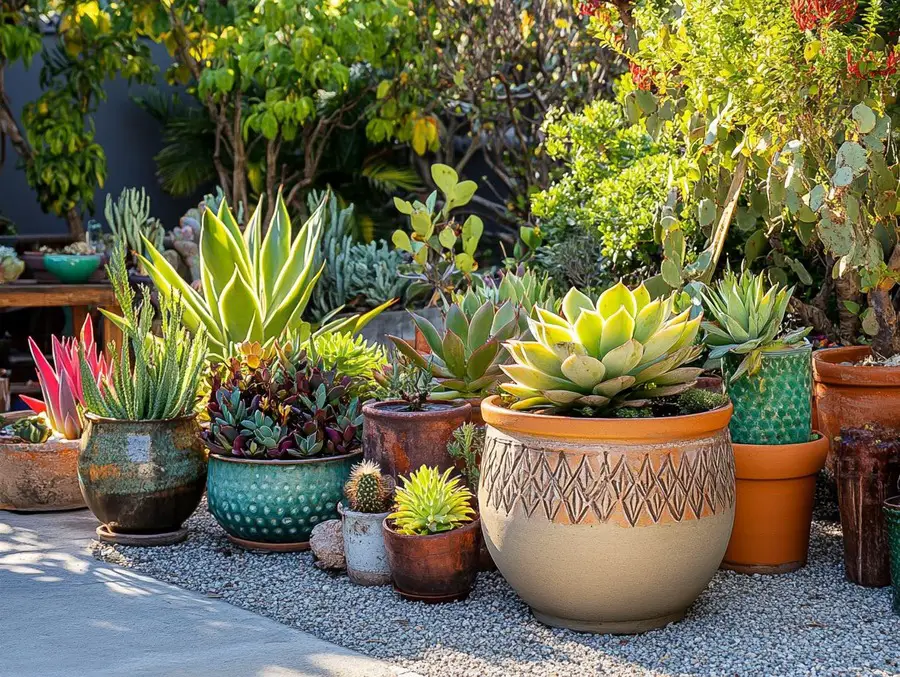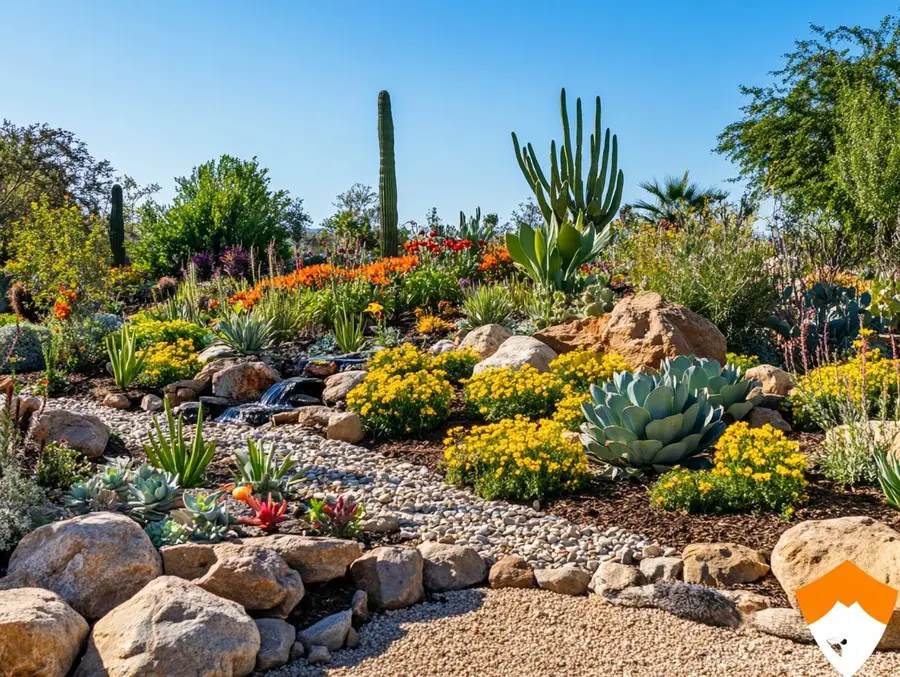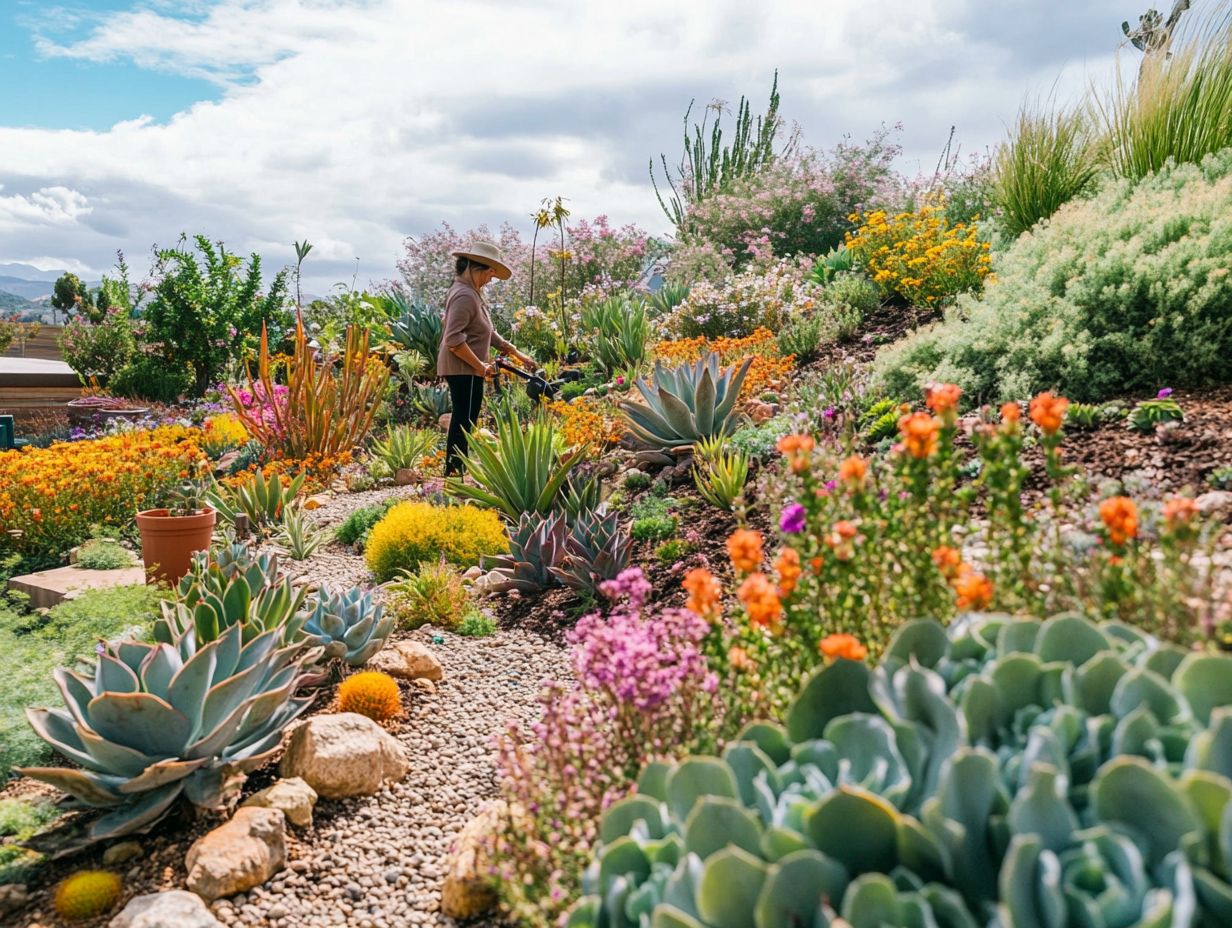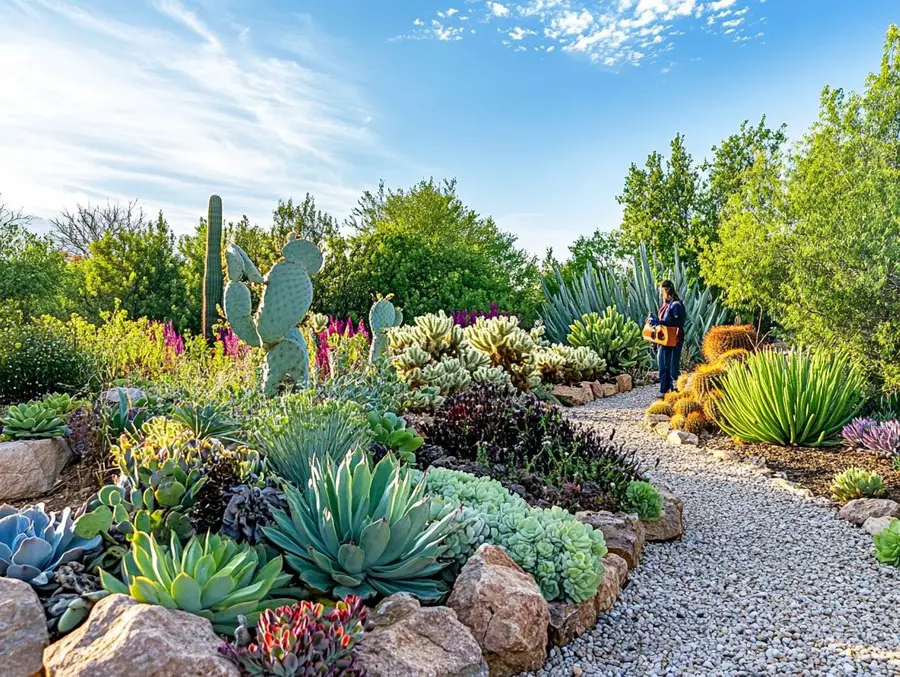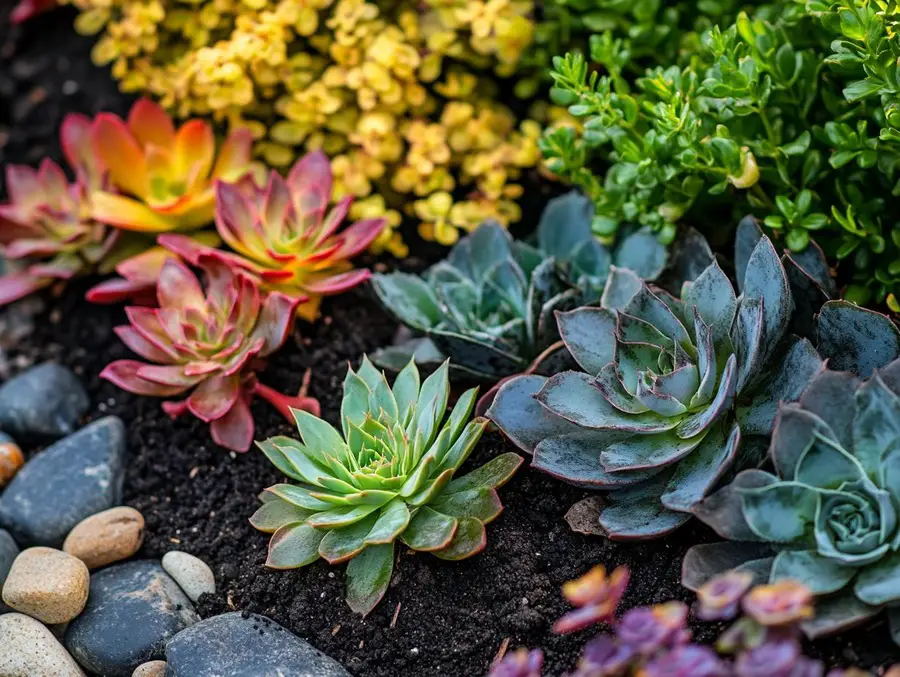We use affiliate links. If you purchase something using one of these links, we may receive compensation or commission.
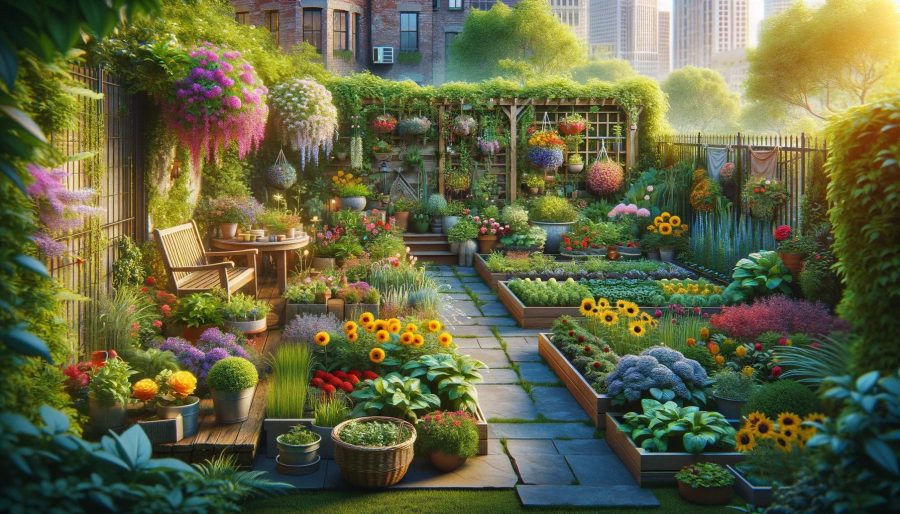
Dive into the world of urban backyard gardening! Transform your city space into a lush oasis with our helpful tips and inspiring ideas.
Urban Backyard Gardening Key Takeaways:
- Urban backyard gardening is the practice of cultivating plants in small or limited urban spaces like backyards, balconies, or rooftops.
- It focuses on maximizing these areas to grow vegetables, herbs, and flowers.
- It provides a green oasis in the city and offers fresh produce, environmental benefits, and mental well-being.
Welcome to the vibrant and enriching world of urban backyard gardening!
Whether you have a tiny balcony or a modest patch of green, we’re here to show you how to turn your urban space into a flourishing garden.
Let’s embark on a journey to create your very own urban green haven!
What is Backyard Gardening?
Urban backyard gardening is a growing trend, especially in densely populated areas where outdoor space is at a premium.
It refers to the practice of cultivating a garden in small or limited spaces typically found in urban environments, such as backyards, balconies, rooftops, or patios.
A garden is a planned space, usually outdoors, set aside for the cultivation, display, and enjoyment of plants and other forms of nature. The single feature identifying even the wildest wild garden is control. The garden can incorporate both natural and artificial materials.
Gardens often have design features including statuary, follies, pergolas, trellises, stumperies, dry creek beds, and water features such as fountains, ponds (with or without fish), waterfalls or creeks.
Some gardens are for ornamental purposes only, while others also produce food crops, sometimes in separate areas, or sometimes intermixed with the ornamental plants.
Food-producing gardens are distinguished from farms by their smaller scale, more labor-intensive methods, and their purpose (enjoyment of a hobby or self-sustenance rather than producing for sale, as in a market garden).
Flower gardens combine plants of different heights, colors, textures, and fragrances to create interest and delight the senses. https://en.wikipedia.org/wiki/Garden
This type of gardening is not only a creative and fulfilling way to engage with nature, but it also provides numerous benefits:
Backyard Gardening Benefits
Here are some backyard garden benefits:
Fresh Produce:
Urban backyard gardening allows individuals to grow their own fruits, vegetables, and herbs, ensuring access to fresh and organic produce right at their doorstep.
This aspect of urban backyard gardening is particularly appealing as it offers a way to control what goes into your food, reducing the reliance on commercially grown produce which may contain pesticides or preservatives.
Growing your own food also ensures that you’re eating seasonally, which can be more nutritious and flavorful.
It encourages a deeper understanding and appreciation for the food we consume, as well as the work involved in growing it.
Having a variety of fresh herbs, vegetables, and fruits readily available not only enriches the diet but also enhances the culinary experience, allowing for more creativity and freshness in cooking.
Additionally, the process of nurturing and watching your food grow from seed to table can be incredibly rewarding and fulfilling, providing a sense of self-sufficiency and connection to the natural world.
Environmental Benefits.
Urban gardens contribute to reducing carbon footprints, improving air quality, and supporting local biodiversity by providing habitats for various birds, bees, and other pollinators.
They help in reducing the carbon footprint by minimizing the distance food travels from farm to table.
This aspect emphasizes the positive impact that urban backyard gardens can have on the environment, particularly in densely populated urban areas.
Mental and Physical Health:
Gardening is known to have therapeutic effects, helping to reduce stress and improve mental well-being. It also encourages physical activity, which can contribute to overall health and fitness.
Educational Opportunities:
Urban backyard gardens offer educational benefits, especially for children. They provide a practical way to learn about plants, food-growing processes, and the importance of sustainability.
Community Engagement:
These gardens can foster a sense of community among urban dwellers.
Shared garden spaces, like community gardens, promote social interaction, cooperation, and a shared sense of achievement.
Space Efficiency:
Urban gardening often involves innovative techniques to maximize limited space.
This includes vertical gardening, container gardening, and the use of trellises and hanging planters.
Aesthetic Enhancement:
Besides their functional benefits, these gardens can beautify urban spaces, turning bland areas into green, lush environments.
Sustainability Practices:
Urban gardeners often adopt sustainable practices such as composting, using recycled materials, and conserving water, which further enhances the environmental benefits of their gardens.
Overall, urban backyard gardening is a versatile and rewarding endeavor that brings a slice of nature into the urban landscape, offering environmental, health, social, and educational benefits.
Getting Started with Urban Backyard Gardening
Urban backyard gardening transforms small city spaces into lush, productive areas.
This introduction explains what urban gardening is and highlights its importance, offering a gateway to sustainable living and a deeper connection with nature, right in the heart of the city.
Read more about Getting Started With Urban Backyard Gardening
Types of Urban Gardens
Discover the various types of urban gardens that can flourish in city environments. From rooftop havens to innovative vertical setups, each type offers unique benefits and challenges, catering to different spaces and gardening preferences.
Rooftop Gardens
Rooftop gardens utilize unused urban space, creating green oases above the city. They can include raised beds, greenhouses, or even urban chicken coops, subject to building regulations and local laws.
Vertical Gardens
Vertical gardens optimize limited space by growing plants on walls or trellises. They can be traditional or use hydroponics, and are perfect for adding greenery and growing food in compact urban areas.
Microgreens
Microgreens are tiny, nutrient-rich vegetable sprouts ideal for small spaces like apartments. They’re easy to grow on windowsills and offer intense flavors and health benefits.
Container Gardening
Container gardening offers flexibility for urban settings. Pots and planters can be moved for optimal sunlight and can house a variety of plants, making them perfect for balconies and patios.
Shipping Container Gardens
Shipping container gardens provide a controlled environment for growing plants.
They’re an innovative solution for challenging climates or areas with limited natural space, suitable for microgreens and leafy greens.
Planning Your Urban Backyard Garden
Effective planning is crucial for successful urban gardening. This section guides you through assessing your available space, understanding the importance of sunlight, and selecting suitable plants for your urban environment.
Assessing Space and Sunlight
Evaluate your urban space for gardening, considering sunlight exposure and potential garden locations. Understanding the sun patterns in your backyard is key to deciding where to plant.
Understanding Soil Quality and Drainage
Soil quality and drainage are vital for plant health. Explore ways to improve poor soil and ensure proper drainage, crucial for a flourishing garden.
Selecting Appropriate Plants
Choose plants based on sun exposure, climate, and personal preferences. Consider ease of care, especially for beginners, and select plants that will thrive in your urban garden setting.
Garden Bed Preparation and Planting Techniques
Preparing your garden bed and employing proper planting techniques lay the foundation for a thriving garden. This section covers essential steps to ready your soil and plant your garden effectively.
Preparing the Garden Bed
A well-prepared garden bed is the foundation for a thriving urban backyard garden.
Proper preparation ensures that your plants have the best environment for growth.
Here’s a step-by-step guide on how to prepare your garden bed effectively:
Step 1: Choosing the Right Location
- Sunlight Assessment: Select a spot that receives adequate sunlight based on the needs of the plants you intend to grow.
- Accessibility: Ensure the location is easily accessible for regular maintenance and watering.
Step 2: Clearing the Area
- Weed Removal: Start by removing all weeds, ensuring you get the roots to prevent them from regrowing.
- Debris Clearance: Clear out any rocks, sticks, and other debris that could obstruct plant growth.
Step 3: Testing and Amending the Soil
- Soil Testing: Conduct a soil test to determine the pH and nutrient levels. This will guide you on what amendments your soil needs.
- Adding Amendments: Based on the soil test results, add necessary amendments. If the soil is too acidic, you might need to add lime. For alkaline soils, sulfur can help balance the pH.
Step 4: Tilling and Aerating the Soil
- Tilling the Soil: Use a garden fork or tiller to loosen the soil. This helps improve drainage and makes it easier for plant roots to penetrate the soil.
- Soil Aeration: Ensure the soil is well-aerated to provide oxygen to the plant roots, which is essential for their growth and health.
Step 5: Adding Organic Matter
- Compost: Mix in a generous amount of compost to enrich the soil with nutrients.
- Other Organic Materials: You can also add aged manure, leaf mold, or peat moss to improve soil fertility and structure.
Step 6: Leveling and Shaping the Bed
- Evening Out the Soil: Use a rake to level the soil, breaking up large clumps.
- Shaping the Bed: Shape your garden bed, considering factors like drainage and the type of plants you will be growing. Raised beds can be a good option for poor drainage areas.
Step 7: Pre-Watering the Soil
- Moistening the Soil: Before planting, water the soil lightly. This helps settle the soil and provides a moist environment for new plants or seeds.
By following these steps, you can create a healthy and nutrient-rich foundation for your urban backyard garden, setting the stage for your plants to grow and thrive.
Testing Soil pH
The pH level of your soil is a crucial factor that influences the overall health and productivity of your garden.
Soil pH affects how well plants can absorb nutrients from the soil.
Understanding and adjusting your soil’s pH is key to creating an optimal growing environment for your plants.
Understanding Soil pH
- pH Scale: Soil pH is measured on a scale from 0 to 14, with 7 being neutral. Below 7 is acidic, and above 7 is alkaline.
- Impact on Plants: Different plants have different pH preferences. Some thrive in acidic soil, while others prefer alkaline or neutral soil.
Testing Soil pH
- DIY Testing Kits: You can purchase a soil pH testing kit from a garden store. These kits usually include a test probe or strips that change color according to the pH of the soil.
- Professional Testing: For a more detailed analysis, you can send a soil sample to a local extension service or a soil testing lab.
Interpreting Test Results
- Reading the Results: Match the color of your test to the provided pH chart. This will give you a basic idea of your soil’s acidity or alkalinity.
- Understanding Plant Needs: Research the pH preference of the plants you wish to grow. This will help you determine if you need to adjust your soil’s pH.
Adjusting Soil pH
- Lowering pH (Making Soil More Acidic): To make alkaline soil more acidic, you can add materials such as sulfur, peat moss, or pine needles.
- Raising pH (Making Soil More Alkaline): To increase the acidity of acidic soil, you can add lime (calcium carbonate) or wood ash.
- Application: Follow the instructions on the amendment packaging for proper application and amounts. It’s better to make gradual adjustments rather than drastic changes.
Regular Monitoring
- Periodic Testing: Soil pH can change over time due to factors like rainfall, fertilizer application, and plant growth. Regular testing, at least annually, is recommended to keep the pH at an optimal level for your plants.
By regularly testing and adjusting your soil’s pH, you can ensure that your plants have access to the nutrients they need for healthy growth.
This proactive approach can lead to a more productive and vibrant garden.
Planting Layout and Design Strategies
A well-thought-out planting layout is crucial for maximizing the productivity and health of your garden.
Strategic planning can optimize the use of space, ensure plants receive adequate sunlight, and enhance the overall aesthetic appeal of your garden.
Here’s how to develop an effective planting layout and design strategy:
Understanding Your Garden’s Environment
- Sun Exposure: Observe how sunlight moves across your garden throughout the day. Place sun-loving plants in the brightest spots and shade-tolerant plants where sunlight is limited.
- Soil Type Assessment: Different plants thrive in different soil types. Match your plants to the soil conditions in your garden or amend the soil to suit your plant choices.
- Local Climate Considerations: Choose plants that are well-suited to your area’s climate, including temperature ranges and seasonal variations.
Designing the Layout
- Plant Height and Spread: Plan your garden layout by considering the mature height and spread of each plant to avoid overcrowding and ensure each plant receives enough light and air circulation.
- Companion Planting: Some plants, when grown together, can improve each other’s health and productivity. Research companion planting combinations that can benefit your garden.
- Succession Planting: Implement succession planting by rotating crops and planting new ones as others are harvested. This keeps the garden productive throughout the growing season.
Aesthetic Considerations
- Color Coordination: Use color to create a visually pleasing garden. Consider the colors of blooms and foliage when arranging plants.
- Texture and Form: Mix plants with different textures and forms for an interesting and dynamic garden design.
- Focal Points: Create focal points with striking plants, garden art, or features like birdbaths or benches.
Maximizing Space
- Vertical Gardening: Utilize vertical space with trellises, wall planters, or climbing plants to grow more in less space.
- Raised Beds and Containers: Consider using raised beds or containers to better control soil conditions and to make garden maintenance easier.
Accessibility and Functionality
- Pathways: Ensure there are pathways for easy access to all plants for maintenance and harvesting.
- Ergonomics: Design your garden with ergonomics in mind, especially if using raised beds or containers, to make gardening activities more comfortable.
By carefully planning your planting layout and considering these factors, you can create a garden that is not only productive but also aesthetically pleasing and enjoyable to work in.
An effective layout ensures that each plant has the space and resources it needs to thrive, leading to a healthier and more bountiful garden.
Ongoing Garden Maintenance (Part 1)
Consistent and proper maintenance is key to the success of any urban garden.
This section addresses crucial tasks such as watering and fertilizing, which are fundamental to keeping your garden healthy and vibrant.
Watering and Irrigation Techniques
Water is vital for plants, but the amount and frequency of watering can vary greatly.
This part of the guide focuses on how to water your garden effectively, taking into account different plant needs and environmental conditions.
- Understanding Plant Needs: Different plants require varying amounts of water. Research the specific needs of each plant in your garden.
- Soil Moisture Check: Before watering, check the soil moisture. Over-watering can be as harmful as under-watering.
- Watering Depth: Water deeply and less frequently to encourage deep root growth, which strengthens plants.
- Time of Day: The best time to water is early morning or late afternoon to reduce water evaporation.
- Drip Irrigation Systems: Consider installing a drip irrigation system for efficient water delivery directly to the plant roots.
- Mulching: Applying mulch around plants helps retain soil moisture and reduces the need for frequent watering.
Fertilizing for Plant Health
Fertilizers are essential for supplying nutrients to plants, especially in urban soils that may lack certain elements. This section covers how to choose and use fertilizers effectively to ensure your plants are well-nourished.
- Types of Fertilizers: Understand the difference between organic and synthetic fertilizers and their impact on your garden.
- Nutrient Requirements: Learn about key nutrients like nitrogen, phosphorus, and potassium, and how they benefit plant growth.
- Fertilizer Application: Apply fertilizer according to the specific needs of your plants and the manufacturer’s instructions.
- Regular Feeding Schedule: Establish a feeding schedule based on the growth stage of your plants and the type of fertilizer used.
- Soil Testing: Periodically test your soil to determine nutrient levels and adjust your fertilizing regimen accordingly.
- Over-fertilizing: Be cautious of over-fertilizing, which can harm plants and disrupt the natural soil balance.
By mastering these maintenance techniques, you can ensure that your urban garden not only survives but thrives, providing a lush and productive green space in the urban environment.
Part 2: Cultivating and Enjoying Your Urban Garden
In Part 2 of our guide to urban backyard gardening, we delve deeper into the aspects that make your garden not just survive, but truly thrive.
This section is dedicated to advanced garden care techniques, harvesting, and enjoying the fruits of your labor.
We’ll explore how to tackle common urban gardening challenges, ways to expand your gardening skills, and the joys of reaping what you’ve sown.
Whether you’re a seasoned green thumb or a budding gardener, these insights will enhance your urban gardening experience, turning your garden into a bountiful and enjoyable oasis amidst the concrete jungle.
Let’s continue our journey into the rewarding world of cultivating and relishing your urban garden.
Ongoing Garden Maintenance (Part 2)
Continuing from the foundational aspects of garden maintenance, this section delves into more nuanced and equally crucial aspects of urban garden care.
Effective weed management and pest control are vital for a garden’s health and productivity, especially in the unique environment of an urban backyard.
Weed Management Strategies
Weeds can be more than just an eyesore; they can also compete with your plants for essential nutrients and sunlight. Effective weed management is key to maintaining a healthy garden.
- Regular Monitoring: Frequently inspect your garden for weeds, especially during the growing season. Early detection makes removal easier and less disruptive to your plants.
- Hand Weeding: Removing weeds by hand is often the most effective method, especially in small gardens. Be sure to pull out the roots to prevent regrowth.
- Mulching: Applying a layer of mulch can suppress weed growth by blocking sunlight. Organic mulches like straw or wood chips also add nutrients to the soil as they decompose.
- Natural Herbicides: For a non-toxic approach, consider natural herbicides like vinegar or corn gluten meal. These can be effective against weeds when applied correctly.
- Barrier Methods: Use landscape fabric or other physical barriers in areas prone to weeds. This can be particularly useful in preventing weeds in pathways or around garden borders.
Pest Control and Natural Repellents
Pests can be a significant challenge in urban gardens. However, there are numerous natural methods to manage them effectively without resorting to harsh chemical pesticides.
- Companion Planting: Some plants can naturally repel pests. For example, marigolds can deter nematodes, while garlic can repel aphids.
- Beneficial Insects: Encourage beneficial insects like ladybugs and lacewings, which prey on common garden pests.
- Natural Sprays and Solutions: Homemade sprays, such as a mixture of water and mild dish soap or neem oil, can be effective against a variety of pests.
- Physical Barriers: Use row covers, netting, or collars around plants to physically prevent pests from reaching them.
- Diatomaceous Earth: This natural powder can be effective against pests like slugs and beetles. Sprinkle it around plants, but be cautious as it can also affect beneficial insects.
- Regular Inspection and Cleaning: Regularly check your plants for signs of pests and remove any infested parts. Keeping the garden clean and free of debris can also reduce pest habitats.
By employing these advanced maintenance techniques, urban gardeners can effectively manage weeds and pests, ensuring their garden remains a healthy and productive haven amidst the urban landscape.
Harvesting and Enjoying Your Produce
Harvesting is one of the most rewarding aspects of urban gardening, where you get to enjoy the fruits (and vegetables) of your labor.
This section covers everything from the right harvesting techniques to the best ways to store and use your fresh produce, ensuring you make the most of your garden’s bounty.
Tips for Successful Harvesting
Timing and technique are key to successful harvesting. Here’s how to ensure you pick your produce at its peak for the best flavor and nutrition.
- Knowing When to Harvest: Understanding the signs of ripeness in different plants is crucial. Vegetables like tomatoes should be fully colored, while leafy greens are best when tender and full-sized.
- Harvesting Techniques: Use sharp scissors or pruning shears for clean cuts, which are less damaging to the plants. For root vegetables, loosen the soil around the plant before pulling.
- Morning Harvesting: Harvesting in the early morning, when temperatures are cooler, can result in crisper, fresher produce.
- Regular Harvesting: Regularly harvesting vegetables like beans and zucchini can encourage the plant to produce more.
Storing and Using Fresh Produce
Proper storage is essential to extend the freshness of your produce. Here’s how to store and use your garden’s yield effectively.
- Refrigeration: Most vegetables, like leafy greens and root vegetables, should be stored in the refrigerator. Some, like onions and potatoes, are best stored in a cool, dry place.
- Preparation for Storage: Clean your produce but wait to wash leafy greens until you’re ready to use them to prevent wilting.
- Creative Cooking: Use your fresh produce in creative recipes. Herbs can be used in sauces and dressings, while vegetables can be the star of salads, soups, and main dishes.
- Preservation Techniques: Consider canning, freezing, or drying surplus produce for long-term storage.
Health Benefits of Fresh, Home-Grown Food
Eating fresh, home-grown produce comes with a host of health benefits. Here’s what makes your garden’s yield not just delicious but also nutritious.
- Nutrient-Rich Food: Freshly harvested produce tends to have higher levels of vitamins and minerals compared to store-bought counterparts, which may lose nutrients during transport and storage.
- Chemical-Free Produce: Growing your own food means you can avoid harmful pesticides and chemicals often found in commercially grown produce.
- Mental Health Benefits: The process of growing and consuming your own food can bring a sense of accomplishment and contribute to overall mental well-being.
By following these tips and techniques, you can enjoy the full spectrum of benefits that come with urban gardening, from the pleasure of harvesting to the joys of eating fresh, home-grown food.
Overcoming Urban Gardening Challenges
Urban gardening, while rewarding, can present several challenges unique to city environments.
This section is dedicated to addressing these challenges and providing practical solutions to ensure the success of your urban garden.
Dealing with Wildlife and Pests
Wildlife and pests can pose significant challenges to urban gardens. Here are some strategies to protect your garden naturally and effectively.
- Identifying Common Pests: Learn to identify common urban garden pests like aphids, slugs, and rodents.
- Natural Repellents: Utilize natural repellents such as garlic, chili pepper sprays, or essential oils to deter pests without harming the environment.
- Physical Barriers: Employ barriers like netting, fencing, or row covers to protect your plants from animals and insects.
- Encouraging Natural Predators: Attract birds or beneficial insects that naturally prey on common garden pests.
- Regular Monitoring: Keep an eye on your plants for early signs of pest infestation, which is easier to manage if caught early.
Addressing Soil Contamination and Erosion
Soil contamination and erosion can be significant issues in urban areas. Here’s how to tackle these problems to maintain a healthy garden.
- Testing for Contaminants: Consider testing your soil for contaminants, especially if you’re gardening in reclaimed urban spaces.
- Using Raised Beds: Raised beds filled with clean soil can be a solution to contaminated or poor-quality ground soil.
- Erosion Control Methods: Implement erosion control strategies like mulching, using ground cover plants, and creating terraces or retaining walls in sloped areas.
- Improving Soil Quality: Regularly add organic matter like compost to improve soil structure and fertility.
Strategies for Limited Space and Harsh Urban Conditions
Urban gardens often have to contend with limited space and challenging conditions. Here are some innovative ways to maximize your gardening potential.
- Vertical Gardening: Utilize vertical spaces with trellises, wall planters, and hanging baskets to grow upwards.
- Container Gardening: Containers and pots offer flexibility and can be used in even the smallest spaces, like balconies or window ledges.
- Microclimate Management: Understand and manage the microclimates in your urban space, such as areas with wind tunnels or heat reflection from buildings, to protect your plants.
- Choosing Resilient Plants: Opt for plants that are resilient to urban conditions, such as drought-tolerant species or those that can thrive in poorer soil conditions.
By addressing these challenges with the right strategies and a bit of creativity, urban gardeners can overcome the obstacles of city gardening and enjoy the numerous benefits of their green spaces.
Expanding and Evolving Your Garden
As you become more adept at urban gardening, there’s an exciting opportunity to grow and transform your backyard garden.
This progression not only enhances the beauty and yield of your garden but also allows you to explore new dimensions of gardening.
This section provides guidance on how to grow your garden in tandem with your growing skills.
Starting Small and Expanding Gradually
Starting with a small, manageable garden is a wise approach for beginners. As you gain confidence and experience, you can gradually expand your garden, adding new elements and varieties.
- Assessing Your Progress: Reflect on what has worked well in your garden and what challenges you’ve faced.
- Incremental Expansion: Gradually increase the size of your garden or the number of plants you grow, ensuring that it remains manageable.
- Adding Diversity: As you expand, consider introducing new plant varieties or experimenting with different gardening styles.
- Learning from Experience: Use the knowledge and skills you’ve acquired to make informed decisions about expanding your garden.
- Planning for Expansion: Create a plan for how you want to develop your garden, considering space, resources, and time.
Exploring Advanced Gardening Techniques and Technologies
As you become more comfortable with basic gardening, exploring advanced techniques and technologies can further enhance your gardening experience.
- Hydroponic Systems: Investigate soil-less gardening with hydroponic systems, which can be particularly effective in urban settings with limited space.
- Aquaponics: Combine fish farming with plant cultivation in an aquaponic system for a sustainable, closed-loop system.
- Smart Gardening Tools: Utilize technology like soil sensors, automated irrigation systems, and climate-controlled environments to optimize plant growth.
- Companion Planting and Crop Rotation: Implement these advanced agricultural practices to improve soil health, maximize space, and control pests and diseases naturally.
- Specialized Gardening Methods: Experiment with specialized techniques such as espalier, grafting, or permaculture principles to diversify your gardening skills.
As you expand your garden and incorporate new techniques and technologies, you open up a world of possibilities.
Urban gardening is a dynamic and evolving hobby, and as your garden grows, so does your connection with nature, your community, and the environment.
Embracing this growth and evolution is part of the joy and journey of urban gardening.
Related Content
Visit my Amazon Influencer Page for videos and gardening products Grow Your Own Garden

